Analysis of Uber's Unfair Dismissal Practices: A Literature Review
VerifiedAdded on 2020/05/11
|6
|1264
|328
Literature Review
AI Summary
This literature review examines Uber's unfair dismissal cases, focusing on the company's treatment of its drivers and the resulting issues. The review highlights the exploitation of drivers by not classifying them as employees, leading to job insecurity and breaches of contract. The study analyzes the significance of the case, the issues involved, and Uber's motives behind its policy changes. It also explores the role of HR policies, corporate social responsibility, and ethical considerations. The research uses a qualitative research design, relying on secondary sources to analyze the impact on drivers and the company's standing in the market. The review concludes that Uber's actions undermine employee rights and negatively affect its global image.
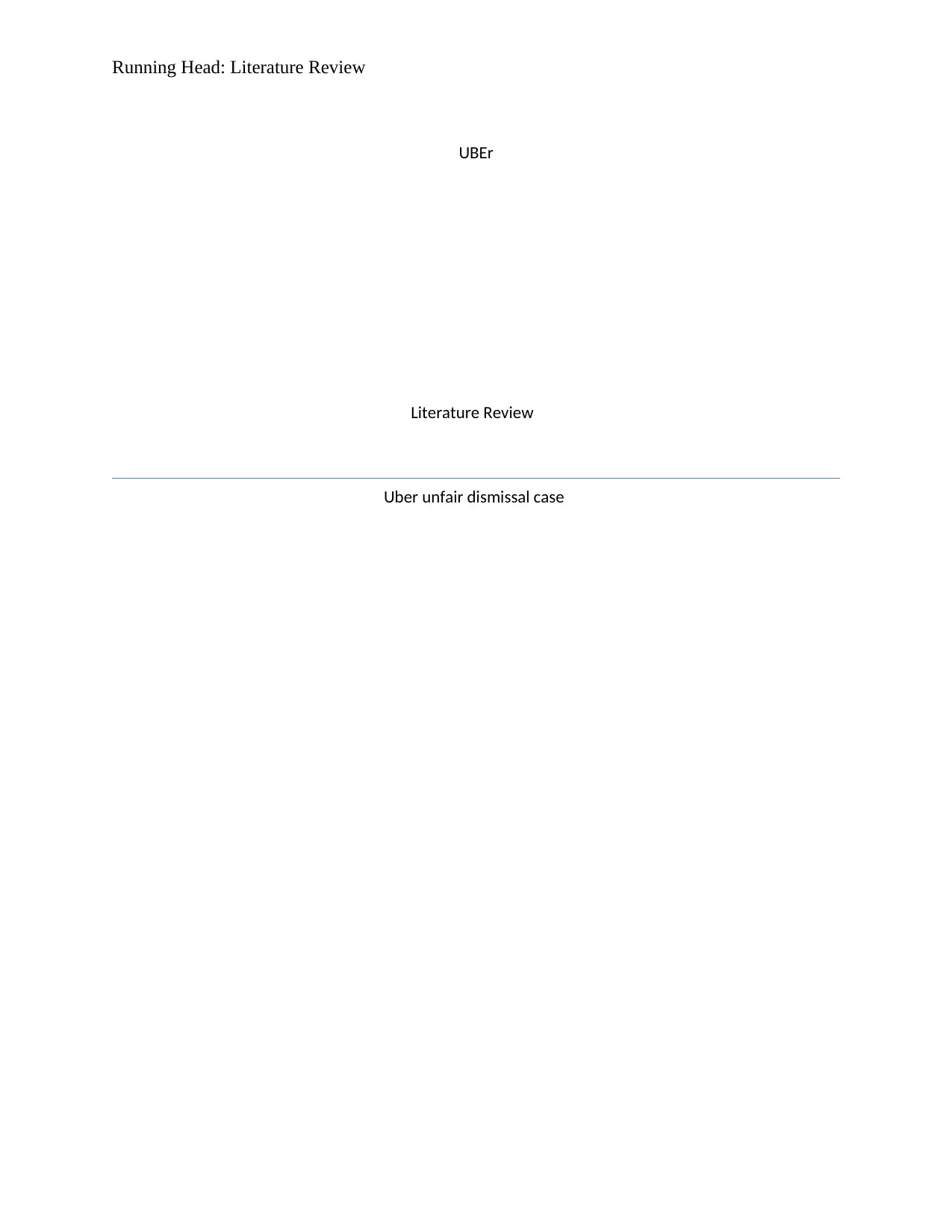
Running Head: Literature Review
UBEr
Literature Review
Uber unfair dismissal case
UBEr
Literature Review
Uber unfair dismissal case
Paraphrase This Document
Need a fresh take? Get an instant paraphrase of this document with our AI Paraphraser
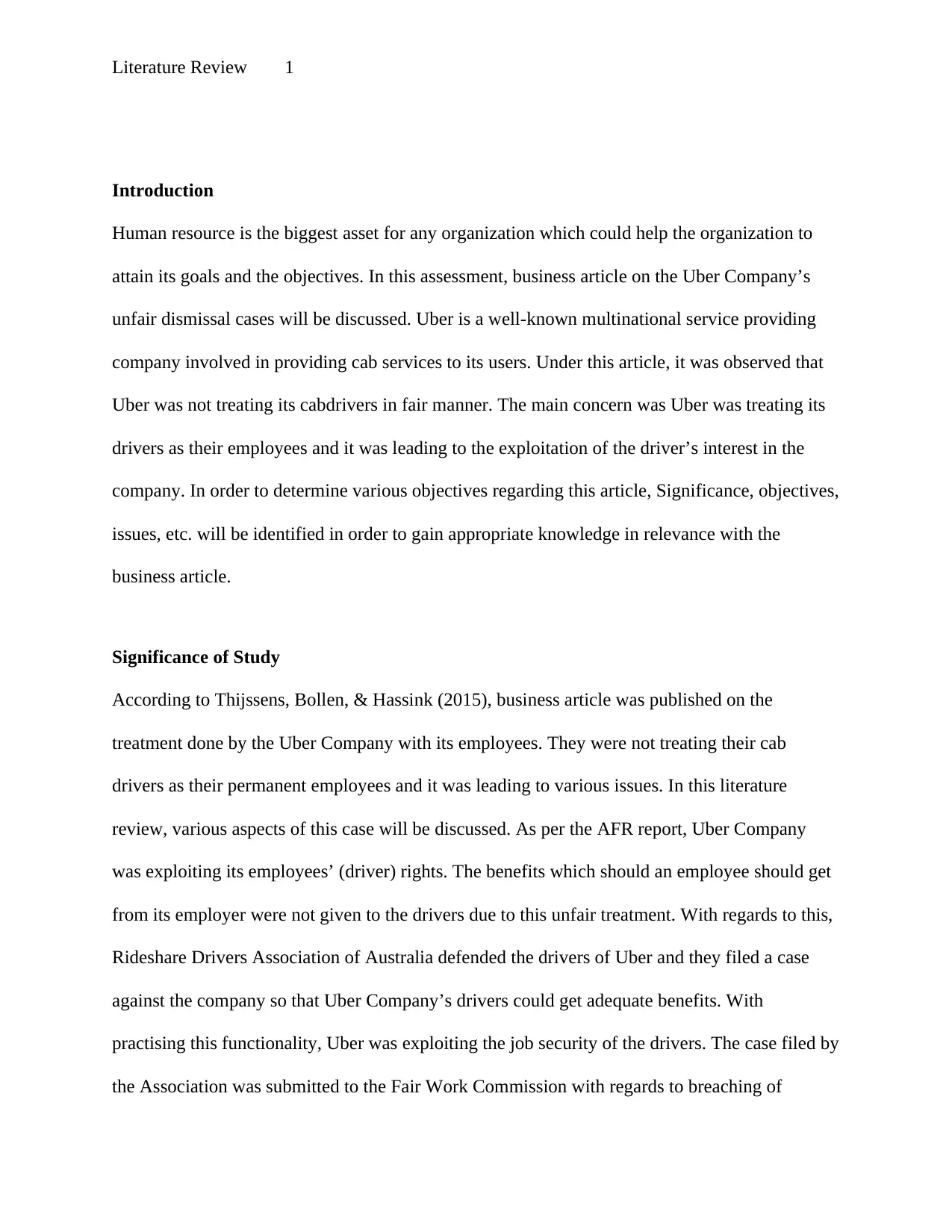
Literature Review 1
Introduction
Human resource is the biggest asset for any organization which could help the organization to
attain its goals and the objectives. In this assessment, business article on the Uber Company’s
unfair dismissal cases will be discussed. Uber is a well-known multinational service providing
company involved in providing cab services to its users. Under this article, it was observed that
Uber was not treating its cabdrivers in fair manner. The main concern was Uber was treating its
drivers as their employees and it was leading to the exploitation of the driver’s interest in the
company. In order to determine various objectives regarding this article, Significance, objectives,
issues, etc. will be identified in order to gain appropriate knowledge in relevance with the
business article.
Significance of Study
According to Thijssens, Bollen, & Hassink (2015), business article was published on the
treatment done by the Uber Company with its employees. They were not treating their cab
drivers as their permanent employees and it was leading to various issues. In this literature
review, various aspects of this case will be discussed. As per the AFR report, Uber Company
was exploiting its employees’ (driver) rights. The benefits which should an employee should get
from its employer were not given to the drivers due to this unfair treatment. With regards to this,
Rideshare Drivers Association of Australia defended the drivers of Uber and they filed a case
against the company so that Uber Company’s drivers could get adequate benefits. With
practising this functionality, Uber was exploiting the job security of the drivers. The case filed by
the Association was submitted to the Fair Work Commission with regards to breaching of
Introduction
Human resource is the biggest asset for any organization which could help the organization to
attain its goals and the objectives. In this assessment, business article on the Uber Company’s
unfair dismissal cases will be discussed. Uber is a well-known multinational service providing
company involved in providing cab services to its users. Under this article, it was observed that
Uber was not treating its cabdrivers in fair manner. The main concern was Uber was treating its
drivers as their employees and it was leading to the exploitation of the driver’s interest in the
company. In order to determine various objectives regarding this article, Significance, objectives,
issues, etc. will be identified in order to gain appropriate knowledge in relevance with the
business article.
Significance of Study
According to Thijssens, Bollen, & Hassink (2015), business article was published on the
treatment done by the Uber Company with its employees. They were not treating their cab
drivers as their permanent employees and it was leading to various issues. In this literature
review, various aspects of this case will be discussed. As per the AFR report, Uber Company
was exploiting its employees’ (driver) rights. The benefits which should an employee should get
from its employer were not given to the drivers due to this unfair treatment. With regards to this,
Rideshare Drivers Association of Australia defended the drivers of Uber and they filed a case
against the company so that Uber Company’s drivers could get adequate benefits. With
practising this functionality, Uber was exploiting the job security of the drivers. The case filed by
the Association was submitted to the Fair Work Commission with regards to breaching of

Literature Review 2
contracts which were made by the company with the drivers. The contract’s terms and conditions
clearly describes that drivers are performing functionalities for company as per the requirement.
In this scenario, company’s liability towards the drivers was nil if they wants to discontinue with
the driver.
Issues
With the effect of this business article, Collings (2014), reviewed the case and argued that this
was leading to enhancement of the job security with the employees (drivers) linked with the
company. As per the Human Resource policies published by the Australian government,
organization needs to work for employees’ interest which is also a corporate social responsibility
from the perceptive of the organization. The major issue which was employees were facing with
the organization’s act was leading to the job insecurity to the drivers. As per the rules and the
regulations, employees have the right to know regarding the amendments made in the policies of
the company. Irrelevance to this fact, Uber Company has overruled this policy and they have
developed contracts under which organization does not need to provide any type of prior notice
before retrenchment of drivers or breaching of contract.
Apart from this, it was also leading to the breaching of the corporate social responsibility in
which organization needs to develop and maintain certain criteria for securing its stakeholder’s
interest. Uber was practising unethical activities which were leading to the development of
negative image in the consumer’s as well as in employees’ mind-sets. Reviewing the
functionalities of the organization, Uber was not following any of the ethical policy in their
working procedure. In the given scenario, driver’s faces any situation while serving for
company; they will not be liable to provide any kind of services or help. This was not only
contracts which were made by the company with the drivers. The contract’s terms and conditions
clearly describes that drivers are performing functionalities for company as per the requirement.
In this scenario, company’s liability towards the drivers was nil if they wants to discontinue with
the driver.
Issues
With the effect of this business article, Collings (2014), reviewed the case and argued that this
was leading to enhancement of the job security with the employees (drivers) linked with the
company. As per the Human Resource policies published by the Australian government,
organization needs to work for employees’ interest which is also a corporate social responsibility
from the perceptive of the organization. The major issue which was employees were facing with
the organization’s act was leading to the job insecurity to the drivers. As per the rules and the
regulations, employees have the right to know regarding the amendments made in the policies of
the company. Irrelevance to this fact, Uber Company has overruled this policy and they have
developed contracts under which organization does not need to provide any type of prior notice
before retrenchment of drivers or breaching of contract.
Apart from this, it was also leading to the breaching of the corporate social responsibility in
which organization needs to develop and maintain certain criteria for securing its stakeholder’s
interest. Uber was practising unethical activities which were leading to the development of
negative image in the consumer’s as well as in employees’ mind-sets. Reviewing the
functionalities of the organization, Uber was not following any of the ethical policy in their
working procedure. In the given scenario, driver’s faces any situation while serving for
company; they will not be liable to provide any kind of services or help. This was not only
⊘ This is a preview!⊘
Do you want full access?
Subscribe today to unlock all pages.

Trusted by 1+ million students worldwide
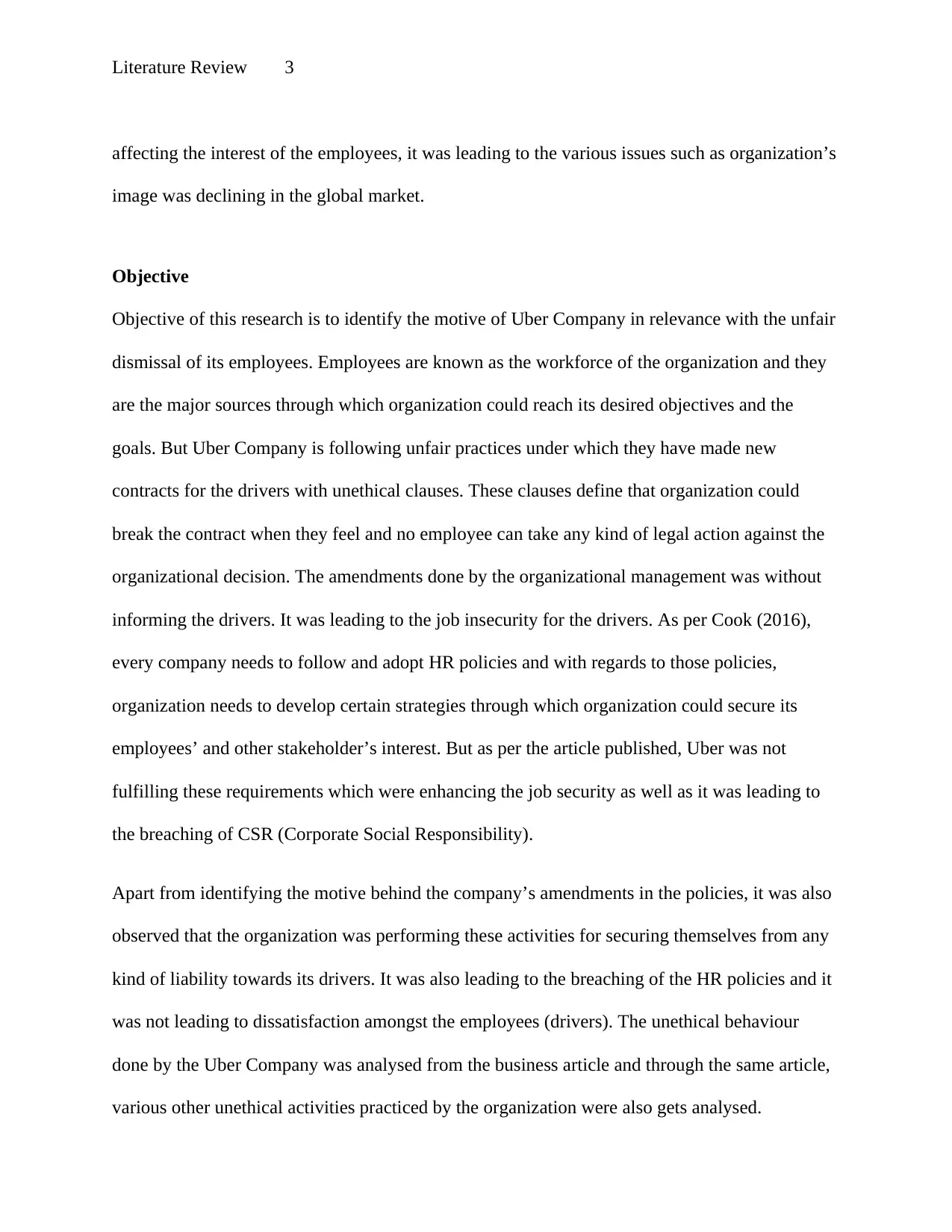
Literature Review 3
affecting the interest of the employees, it was leading to the various issues such as organization’s
image was declining in the global market.
Objective
Objective of this research is to identify the motive of Uber Company in relevance with the unfair
dismissal of its employees. Employees are known as the workforce of the organization and they
are the major sources through which organization could reach its desired objectives and the
goals. But Uber Company is following unfair practices under which they have made new
contracts for the drivers with unethical clauses. These clauses define that organization could
break the contract when they feel and no employee can take any kind of legal action against the
organizational decision. The amendments done by the organizational management was without
informing the drivers. It was leading to the job insecurity for the drivers. As per Cook (2016),
every company needs to follow and adopt HR policies and with regards to those policies,
organization needs to develop certain strategies through which organization could secure its
employees’ and other stakeholder’s interest. But as per the article published, Uber was not
fulfilling these requirements which were enhancing the job security as well as it was leading to
the breaching of CSR (Corporate Social Responsibility).
Apart from identifying the motive behind the company’s amendments in the policies, it was also
observed that the organization was performing these activities for securing themselves from any
kind of liability towards its drivers. It was also leading to the breaching of the HR policies and it
was not leading to dissatisfaction amongst the employees (drivers). The unethical behaviour
done by the Uber Company was analysed from the business article and through the same article,
various other unethical activities practiced by the organization were also gets analysed.
affecting the interest of the employees, it was leading to the various issues such as organization’s
image was declining in the global market.
Objective
Objective of this research is to identify the motive of Uber Company in relevance with the unfair
dismissal of its employees. Employees are known as the workforce of the organization and they
are the major sources through which organization could reach its desired objectives and the
goals. But Uber Company is following unfair practices under which they have made new
contracts for the drivers with unethical clauses. These clauses define that organization could
break the contract when they feel and no employee can take any kind of legal action against the
organizational decision. The amendments done by the organizational management was without
informing the drivers. It was leading to the job insecurity for the drivers. As per Cook (2016),
every company needs to follow and adopt HR policies and with regards to those policies,
organization needs to develop certain strategies through which organization could secure its
employees’ and other stakeholder’s interest. But as per the article published, Uber was not
fulfilling these requirements which were enhancing the job security as well as it was leading to
the breaching of CSR (Corporate Social Responsibility).
Apart from identifying the motive behind the company’s amendments in the policies, it was also
observed that the organization was performing these activities for securing themselves from any
kind of liability towards its drivers. It was also leading to the breaching of the HR policies and it
was not leading to dissatisfaction amongst the employees (drivers). The unethical behaviour
done by the Uber Company was analysed from the business article and through the same article,
various other unethical activities practiced by the organization were also gets analysed.
Paraphrase This Document
Need a fresh take? Get an instant paraphrase of this document with our AI Paraphraser
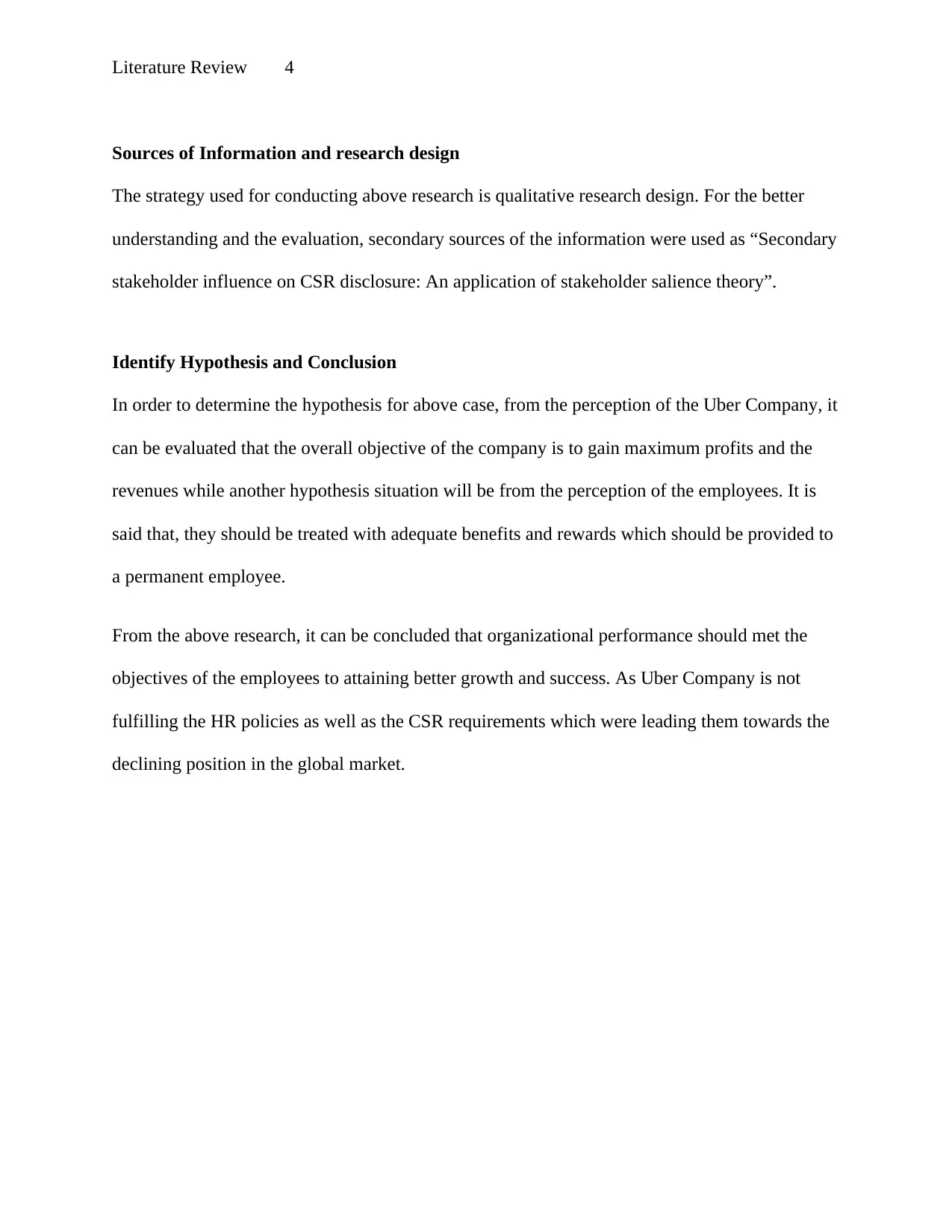
Literature Review 4
Sources of Information and research design
The strategy used for conducting above research is qualitative research design. For the better
understanding and the evaluation, secondary sources of the information were used as “Secondary
stakeholder influence on CSR disclosure: An application of stakeholder salience theory”.
Identify Hypothesis and Conclusion
In order to determine the hypothesis for above case, from the perception of the Uber Company, it
can be evaluated that the overall objective of the company is to gain maximum profits and the
revenues while another hypothesis situation will be from the perception of the employees. It is
said that, they should be treated with adequate benefits and rewards which should be provided to
a permanent employee.
From the above research, it can be concluded that organizational performance should met the
objectives of the employees to attaining better growth and success. As Uber Company is not
fulfilling the HR policies as well as the CSR requirements which were leading them towards the
declining position in the global market.
Sources of Information and research design
The strategy used for conducting above research is qualitative research design. For the better
understanding and the evaluation, secondary sources of the information were used as “Secondary
stakeholder influence on CSR disclosure: An application of stakeholder salience theory”.
Identify Hypothesis and Conclusion
In order to determine the hypothesis for above case, from the perception of the Uber Company, it
can be evaluated that the overall objective of the company is to gain maximum profits and the
revenues while another hypothesis situation will be from the perception of the employees. It is
said that, they should be treated with adequate benefits and rewards which should be provided to
a permanent employee.
From the above research, it can be concluded that organizational performance should met the
objectives of the employees to attaining better growth and success. As Uber Company is not
fulfilling the HR policies as well as the CSR requirements which were leading them towards the
declining position in the global market.
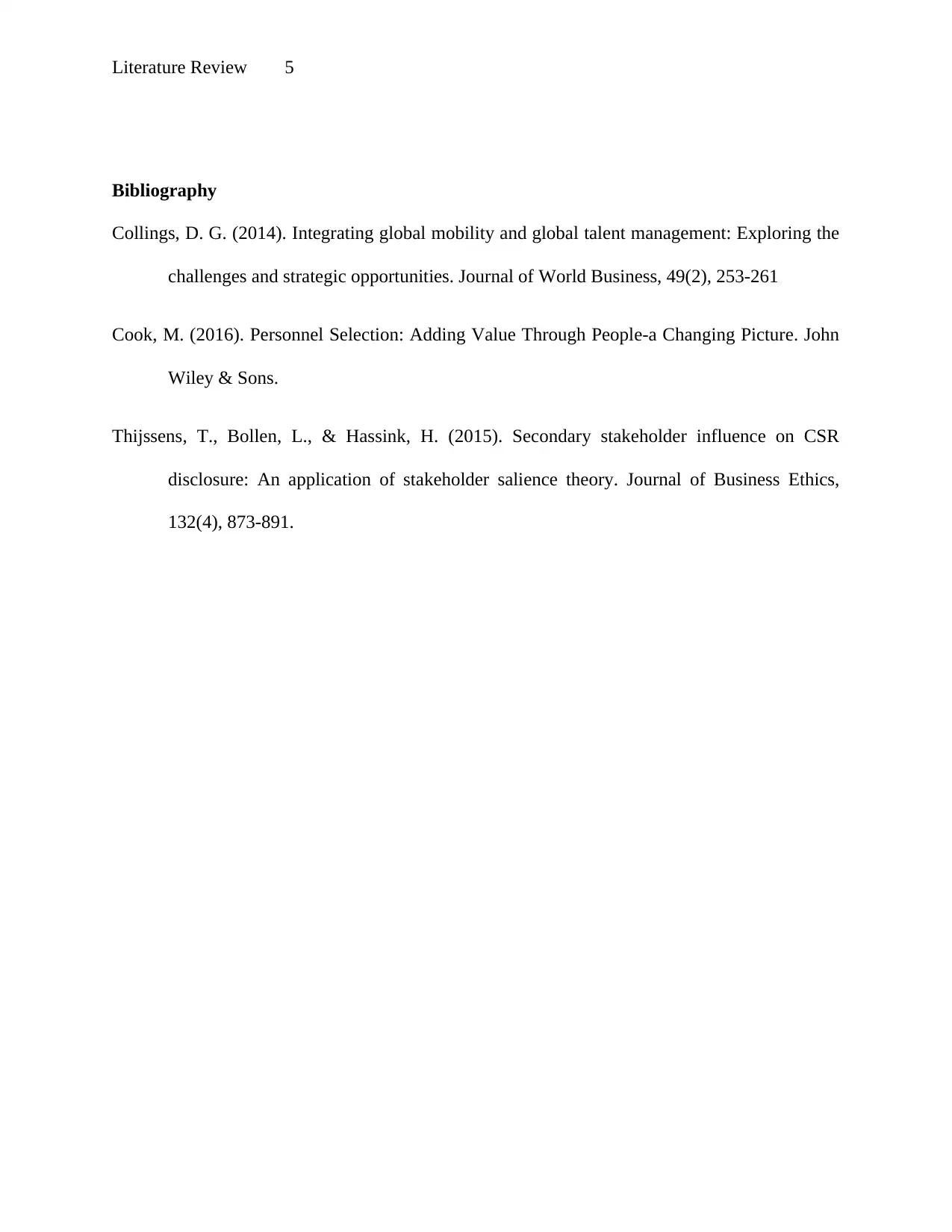
Literature Review 5
Bibliography
Collings, D. G. (2014). Integrating global mobility and global talent management: Exploring the
challenges and strategic opportunities. Journal of World Business, 49(2), 253-261
Cook, M. (2016). Personnel Selection: Adding Value Through People-a Changing Picture. John
Wiley & Sons.
Thijssens, T., Bollen, L., & Hassink, H. (2015). Secondary stakeholder influence on CSR
disclosure: An application of stakeholder salience theory. Journal of Business Ethics,
132(4), 873-891.
Bibliography
Collings, D. G. (2014). Integrating global mobility and global talent management: Exploring the
challenges and strategic opportunities. Journal of World Business, 49(2), 253-261
Cook, M. (2016). Personnel Selection: Adding Value Through People-a Changing Picture. John
Wiley & Sons.
Thijssens, T., Bollen, L., & Hassink, H. (2015). Secondary stakeholder influence on CSR
disclosure: An application of stakeholder salience theory. Journal of Business Ethics,
132(4), 873-891.
⊘ This is a preview!⊘
Do you want full access?
Subscribe today to unlock all pages.

Trusted by 1+ million students worldwide
1 out of 6
Related Documents
Your All-in-One AI-Powered Toolkit for Academic Success.
+13062052269
info@desklib.com
Available 24*7 on WhatsApp / Email
![[object Object]](/_next/static/media/star-bottom.7253800d.svg)
Unlock your academic potential
Copyright © 2020–2025 A2Z Services. All Rights Reserved. Developed and managed by ZUCOL.





